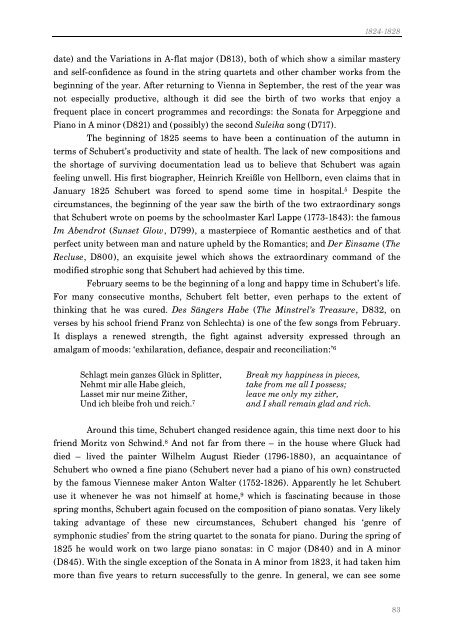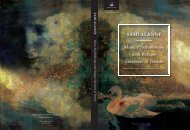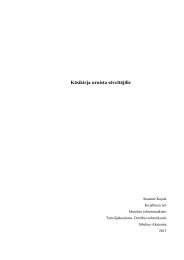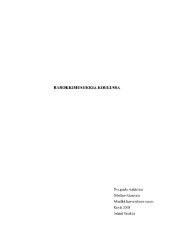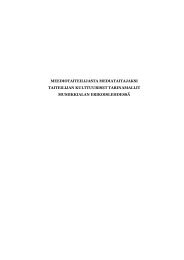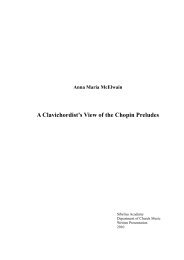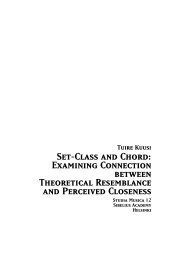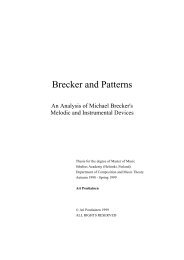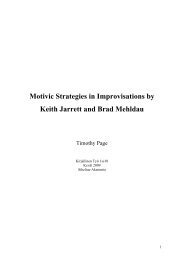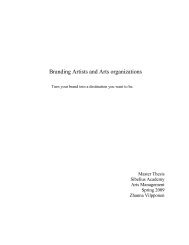The Unfinished Piano Sonatas of Franz Schubert Javier ... - Ethesis
The Unfinished Piano Sonatas of Franz Schubert Javier ... - Ethesis
The Unfinished Piano Sonatas of Franz Schubert Javier ... - Ethesis
You also want an ePaper? Increase the reach of your titles
YUMPU automatically turns print PDFs into web optimized ePapers that Google loves.
1824-1828<br />
date) and the Variations in A-flat major (D813), both <strong>of</strong> which show a similar mastery<br />
and self-confidence as found in the string quartets and other chamber works from the<br />
beginning <strong>of</strong> the year. After returning to Vienna in September, the rest <strong>of</strong> the year was<br />
not especially productive, although it did see the birth <strong>of</strong> two works that enjoy a<br />
frequent place in concert programmes and recordings: the Sonata for Arpeggione and<br />
<strong>Piano</strong> in A minor (D821) and (possibly) the second Suleika song (D717).<br />
<strong>The</strong> beginning <strong>of</strong> 1825 seems to have been a continuation <strong>of</strong> the autumn in<br />
terms <strong>of</strong> <strong>Schubert</strong>’s productivity and state <strong>of</strong> health. <strong>The</strong> lack <strong>of</strong> new compositions and<br />
the shortage <strong>of</strong> surviving documentation lead us to believe that <strong>Schubert</strong> was again<br />
feeling unwell. His first biographer, Heinrich Kreißle von Hellborn, even claims that in<br />
January 1825 <strong>Schubert</strong> was forced to spend some time in hospital. 5 Despite the<br />
circumstances, the beginning <strong>of</strong> the year saw the birth <strong>of</strong> the two extraordinary songs<br />
that <strong>Schubert</strong> wrote on poems by the schoolmaster Karl Lappe (1773-1843): the famous<br />
Im Abendrot (Sunset Glow, D799), a masterpiece <strong>of</strong> Romantic aesthetics and <strong>of</strong> that<br />
perfect unity between man and nature upheld by the Romantics; and Der Einsame (<strong>The</strong><br />
Recluse, D800), an exquisite jewel which shows the extraordinary command <strong>of</strong> the<br />
modified strophic song that <strong>Schubert</strong> had achieved by this time.<br />
February seems to be the beginning <strong>of</strong> a long and happy time in <strong>Schubert</strong>’s life.<br />
For many consecutive months, <strong>Schubert</strong> felt better, even perhaps to the extent <strong>of</strong><br />
thinking that he was cured. Des Sängers Habe (<strong>The</strong> Minstrel’s Treasure, D832, on<br />
verses by his school friend <strong>Franz</strong> von Schlechta) is one <strong>of</strong> the few songs from February.<br />
It displays a renewed strength, the fight against adversity expressed through an<br />
amalgam <strong>of</strong> moods: ‘exhilaration, defiance, despair and reconciliation:’ 6<br />
Schlagt mein ganzes Glück in Splitter,<br />
Nehmt mir alle Habe gleich,<br />
Lasset mir nur meine Zither,<br />
Und ich bleibe froh und reich. 7<br />
Break my happiness in pieces,<br />
take from me all I possess;<br />
leave me only my zither,<br />
and I shall remain glad and rich.<br />
Around this time, <strong>Schubert</strong> changed residence again, this time next door to his<br />
friend Moritz von Schwind. 8 And not far from there – in the house where Gluck had<br />
died – lived the painter Wilhelm August Rieder (1796-1880), an acquaintance <strong>of</strong><br />
<strong>Schubert</strong> who owned a fine piano (<strong>Schubert</strong> never had a piano <strong>of</strong> his own) constructed<br />
by the famous Viennese maker Anton Walter (1752-1826). Apparently he let <strong>Schubert</strong><br />
use it whenever he was not himself at home, 9 which is fascinating because in those<br />
spring months, <strong>Schubert</strong> again focused on the composition <strong>of</strong> piano sonatas. Very likely<br />
taking advantage <strong>of</strong> these new circumstances, <strong>Schubert</strong> changed his ‘genre <strong>of</strong><br />
symphonic studies’ from the string quartet to the sonata for piano. During the spring <strong>of</strong><br />
1825 he would work on two large piano sonatas: in C major (D840) and in A minor<br />
(D845). With the single exception <strong>of</strong> the Sonata in A minor from 1823, it had taken him<br />
more than five years to return successfully to the genre. In general, we can see some<br />
83


